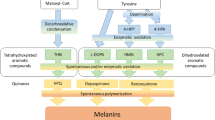Abstract
Gas vesicles are intracellular, microbial flotation devices that consist of mainly one protein, GvpA. The formation of halobacterial gas vesicles occurs along a complex pathway involving 14 different gvp genes that are clustered in a genomic region termed the “vac region”. Various vac regions found in Halobacterium salinarum (p-vac and c-vac), Haloferax mediterranei (mc-vac), and Natronobacterium vacuolatum (nv-vac) have been investigated. Except for the latter vac region, the arrangement of the gvp genes is identical. Single gvp genes have been mutated to study the effect on gas vesicle synthesis in transformants and to determine their possible function. Each vac region exhibits a characteristic transcription pattern, and regulatory steps have been observed at the DNA, RNA, and protein level, indicating a complex regulatory network acting during gas vesicle gene expression.
Similar content being viewed by others
Author information
Authors and Affiliations
Additional information
Received: 13 November 1996 / Accepted: 17 January 1997
Rights and permissions
About this article
Cite this article
Pfeifer, F., Krüger, K., Röder, R. et al. Gas vesicle formation in halophilic Archaea. Arch Microbiol 167, 259–268 (1997). https://doi.org/10.1007/s002030050441
Issue Date:
DOI: https://doi.org/10.1007/s002030050441




